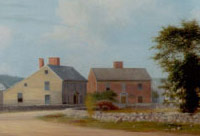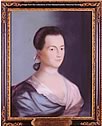
 John
Quincy Adams (JQA) grows up in the northern part of the small rural
town of Braintree, Massachusetts, now Quincy. On horseback it takes
the better part of a day to ride into and back from Boston, a chore
young JQA often performs to send and pick up mail (his father being
the most important correspondent) and to fetch supplies. His love of
this rocky seaside landscape of open vistas and forests remains with
him even after extensive travels in Europe and North America.
John
Quincy Adams (JQA) grows up in the northern part of the small rural
town of Braintree, Massachusetts, now Quincy. On horseback it takes
the better part of a day to ride into and back from Boston, a chore
young JQA often performs to send and pick up mail (his father being
the most important correspondent) and to fetch supplies. His love of
this rocky seaside landscape of open vistas and forests remains with
him even after extensive travels in Europe and North America.
 JQA’s
mother, born Abigail Smith, is the daughter of a prominent minister
from neighboring Weymouth. Although she receives no formal schooling,
she is an avid reader who develops a powerful and distinct style of
writing. She has four children who survive to adulthood. The oldest,
Abigail 2d, is followed by three brothers: John Quincy, Charles, and
Thomas Boylston.
JQA’s
mother, born Abigail Smith, is the daughter of a prominent minister
from neighboring Weymouth. Although she receives no formal schooling,
she is an avid reader who develops a powerful and distinct style of
writing. She has four children who survive to adulthood. The oldest,
Abigail 2d, is followed by three brothers: John Quincy, Charles, and
Thomas Boylston.
JQA’s father, who will become the second president of the United
States, is a practicing attorney. He rides the court circuit from Maine
(then part of Massachusetts) to Cape Cod, but until JQA turns seven,
he is usually home with his family in Boston or on their family farm.
 In
1774, the family routine changes forever. John Adams leaves for Philadelphia
as a delegate to the congress that will take a united stand against
British policies. John Adams will spend the rest of his career embroiled
in the politics of independence and of establishing a new nation. As
he helps fill in for his missing father, JQA will assume a number of
adult chores and responsibilities.
In
1774, the family routine changes forever. John Adams leaves for Philadelphia
as a delegate to the congress that will take a united stand against
British policies. John Adams will spend the rest of his career embroiled
in the politics of independence and of establishing a new nation. As
he helps fill in for his missing father, JQA will assume a number of
adult chores and responsibilities.
While often separated from one another by great distances, the Adamses "listen" carefully to one another in their correspondence, and their commitment to family shines through their letters. The letters of section 1 are among the earliest surviving writings of John Quincy Adams. They reveal a great deal about the emerging personality of a young boy who will grow up to become a secretary of state, the sixth president of the United States, and later an influential congressman.
Image
credits:
• Birthplaces
of John Adams and John Quincy Adams. Watercolor by G. N. Frankenstein,
1849.
Courtesy of the Adams National Historic Site, National Park Service.
•
Abigail Adams.
Pastel on paper by
Benjamin Blyth,
ca. 1766. Massachusetts Historical Society.
•
John
Adams. Pastel
on paper by
Benjamin Blyth,
ca. 1766. Massachusetts Historical Society.